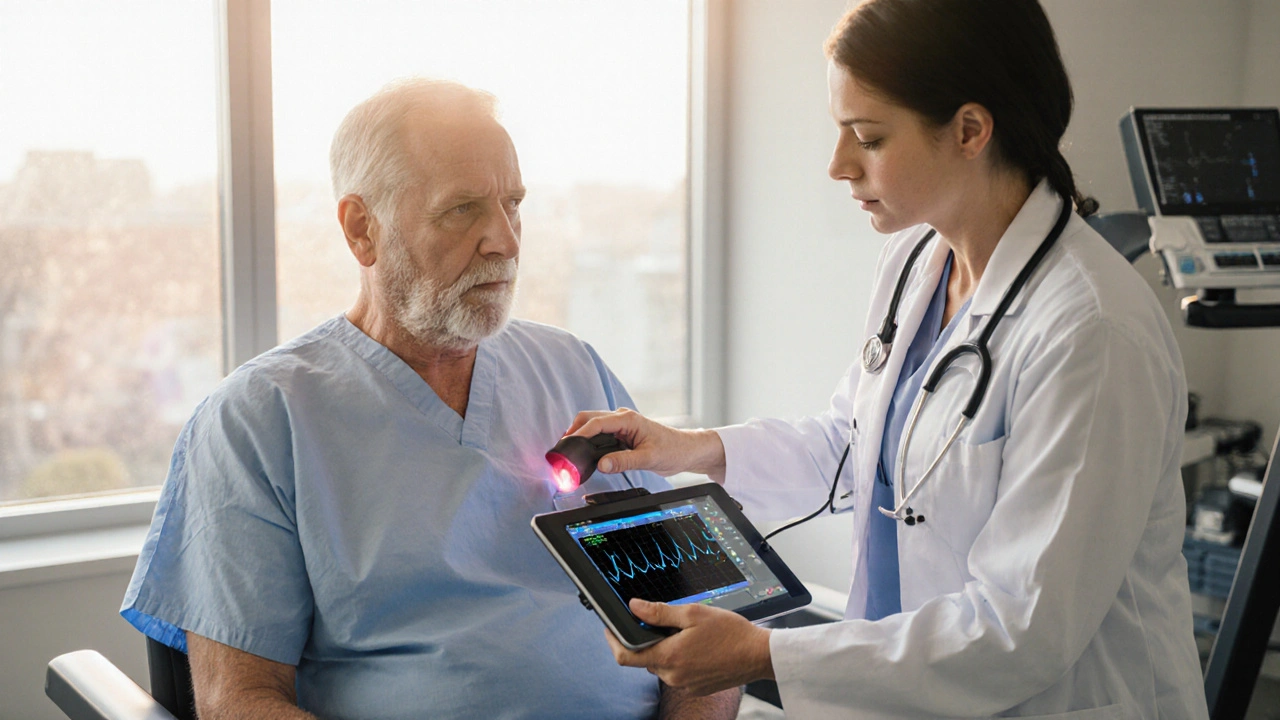VO2 Max Estimator for Left Ventricular Dysfunction
This tool estimates your predicted VO2 max based on age, gender, and exercise tolerance level. Lower VO2 max values may indicate reduced exercise tolerance due to left ventricular dysfunction.
TL;DR
- Left ventricular dysfunction (LVD) reduces the heart’s pumping power, limiting oxygen delivery during activity.
- Lower ejection fraction and higher NYHA class directly correlate with poorer exercise tolerance.
- Cardiopulmonary exercise testing (CPET) and VO2 max measurements quantify the impact.
- Medication optimization, tailored aerobic training, and cardiac rehabilitation can improve capacity.
- Seek medical advice if you notice rapid breathlessness, fatigue, or swelling during routine tasks.
What is Left Ventricular Dysfunction?
Left Ventricular Dysfunction is a condition where the left side of the heart cannot contract or relax effectively enough to move blood through the body. It often shows up as a reduced ejection fractionthe percentage of blood pumped out of the left ventricle with each heartbeat, typically below 50%.
The left ventricle, the heart’s main pumping chamber, is responsible for delivering oxygen‑rich blood to organs and muscles. When its performance drops, the whole circulatory system feels the strain.
How LVD Affects Exercise Tolerance
During exercise, muscles demand more oxygen. The heart meets that demand by increasing stroke volume and heart rate. If left ventricular dysfunction is present, the heart can’t boost output sufficiently, leading to early fatigue, breathlessness, and an overall reduced exercise tolerancethe ability to sustain physical activity without undue symptoms.
Two physiological mechanisms drive the limitation:
- Reduced cardiac output: The weakened left ventricle ejects less blood per beat, cutting the oxygen supply to working muscles.
- Elevated filling pressures: The heart backs up blood into the lungs, causing shortness of breath (pulmonary congestion) even at low workloads.
Both factors push the onset of dyspnea and leg fatigue to much earlier points in an activity.
Measuring the Impact: CPET and VO2 Max
Clinicians use cardiopulmonary exercise testinga lab test that records heart, lung, and metabolic responses while a patient exercises to gauge how LVD limits performance. The key metric is VO2 maxthe highest amount of oxygen the body can use during intense exercise, measured in milliliters per kilogram per minute (ml/kg/min).
Typical VO2 max values:
- Healthy adults: 35-45ml/kg/min (men) / 30-40ml/kg/min (women)
- Patients with mild LVD (EF45‑55%): 20‑30ml/kg/min
- Severe LVD (EF<30%): <15ml/kg/min, often classIII‑IV on the NYHA scale
These numbers translate directly into everyday capabilities - a person with a VO2 max of 12ml/kg/min may struggle to climb a single flight of stairs without gasping.

Clinical Staging: NYHA Classification
The NYHA classificationa functional grading system ranging from I (no symptoms) to IV (symptoms at rest) helps clinicians match symptom burden with treatment intensity. In LVD, the class often mirrors the degree of exercise intolerance:
- Class I: Normal activity, no limitation.
- Class II: Comfortable at rest, slight limitation with ordinary exertion.
- Class III: Marked limitation; less than ordinary activity causes symptoms.
- Class IV: Symptoms even at rest, severe limitation.
Understanding where a patient falls guides decisions about medication titration, device therapy, and referral to cardiac rehabilitationstructured exercise and education programs for heart‑disease patients.
Managing the Decline in Exercise Capacity
Improving tolerance isn’t about a miracle drug; it’s a blend of optimized therapy, lifestyle tweaks, and supervised training.
Medication Optimization
Evidence‑based drugs that enhance ventricular performance include:
- Beta‑blockers: Reduce heart‑rate demand and improve filling time.
- ACE inhibitors/ARBs: Lower afterload, making it easier for the left ventricle to eject blood.
- Mineralocorticoid receptor antagonists: Decrease fluid retention, easing pulmonary congestion.
- SGLT2 inhibitors: Recent trials show modest gains in VO2 max and quality of life.
Regular follow‑up with a cardiologist ensures doses are titrated to the highest tolerable levels.
Tailored Aerobic Training
Even a weak heart can adapt. Guidelines recommend:
- Frequency: 3-5 days per week.
- Intensity: 40‑60% of heart‑rate reserve (the “talk test” works well).
- Duration: Start with 10‑15minutes, build to 30‑45minutes.
- Mode: Walking, stationary cycling, or low‑impact elliptical - whichever feels safest.
Progress should be tracked via perceived exertion or a simple pulse‑oximeter; a rise in resting or post‑exercise heart rate may signal over‑training.
Cardiac Rehabilitation Programs
These multi‑disciplinary clinics combine exercise, nutrition counseling, stress management, and medication education. Studies show participants improve VO2 max by 2‑4ml/kg/min on average, often enough to move from NYHAIII to II.
Practical Tips to Boost Daily Activity
Beyond formal training, small habits make a big difference:
- Break it up: Instead of a single 30‑minute walk, try three 10‑minute strolls spread through the day.
- Monitor fluid intake: Excess fluid can worsen pulmonary congestion; follow your doctor’s guidelines.
- Stay upright after meals: Lying down too soon can increase venous return and breathing difficulty.
- Warm‑up and cool‑down: Five minutes of gentle movement prepares the heart for activity and reduces abrupt heart‑rate spikes.
- Use assistive devices if needed: A cane or walker can conserve energy while you rebuild stamina.
When to Seek Medical Attention
If you notice any of the following, call your healthcare provider promptly:
- Sudden increase in shortness of breath during light tasks.
- Chest discomfort or pressure lasting more than a few minutes.
- Rapid weight gain (≥2kg in 3‑5days) indicating fluid retention.
- Swelling of ankles, feet, or abdomen.
- Feeling faint or dizzy while standing.
Early intervention can prevent hospitalization and may allow medication adjustments that improve your exercise capacity.
Bottom Line
Left ventricular dysfunction creates a cascade that limits how much oxygen your muscles receive, directly curbing exercise tolerance. By measuring impact with CPET, classifying severity with NYHA, and applying a mix of optimized drugs, personalized aerobic exercise, and cardiac rehabilitation, most patients can reclaim a meaningful level of activity. Stay vigilant, follow your care plan, and remember that gradual, consistent effort beats a risky “push‑through” every time.

Frequently Asked Questions
Can mild left ventricular dysfunction be asymptomatic?
Yes. Many people with an ejection fraction between 50‑55% feel normal and only discover the issue during routine imaging. Symptoms usually appear when the heart’s pumping ability drops below about 45%.
How does VO2 max differ from heart rate?
VO2 max measures how much oxygen your body can use, while heart rate tracks how fast the heart beats. A higher VO2 max indicates better aerobic fitness even if heart rate looks normal.
Is it safe to do high‑intensity interval training (HIIT) with LVD?
Only under strict medical supervision. For most patients, moderate continuous exercise is safer. HIIT may be introduced later if the heart tolerates low‑intensity work well.
Do beta‑blockers make me feel more tired during workouts?
Initially, they can reduce your maximum heart rate, making exertion feel harder. After a few weeks, the heart works more efficiently and fatigue often improves.
Can diet alone improve exercise tolerance?
A heart‑healthy diet (low sodium, balanced fats, plenty of fruits and veggies) supports overall cardiovascular function, but without exercise and medication the impact on VO2 max is limited.


Comments (13)
Elaine Curry
You’ve got a decent rundown of the mechanics but I’m gonna throw a curveball here. When you talk about VO2 max the waters get muddier because a lot of people skip the nitty‑gritty of preload and afterload. I once asked my doc if I could bench press during a CPET just to see what happened and he laughed. The heart’s not just a pump, it’s a pressure sensor and a hormonal hub. So if you’re only looking at ejection fraction you’re missing the bigger picture.
Anthony Aspeitia-Orozco
That’s a fair point, especially when you consider the interplay between cardiac output and peripheral extraction. It’s easy to get tunnel‑visioned on numbers without appreciating the physiologic cascade. Encouraging patients to understand how each component fits can empower them to stick with rehab.
Adam Dicker
Listen up folks, the heart’s not gonna forgive you for half‑assing cardio! If you’re aiming to boost that VO2 max, you’ve got to push past the comfort zone, crank up the intensity, and keep that training frequency consistent. No excuses!
Molly Beardall
Oh wow, look at you turning cardio into a courtroom drama. Your ‘no‑excuses’ mantra sounds like a broken record, and honestly it’s a bit over‑the‑top – maybe you’d remember that even the strongest engine needs a pit stop. Also, did you mean ‘cardio’ not ‘cardio’? Just saying.
Brian Pellot
Understanding how left ventricular dysfunction trims your exercise capacity is crucial for anyone trying to stay active.
First, recognize that the heart’s pumping ability is measured by ejection fraction, and when that drops below 50 %, the body’s oxygen delivery starts to lag.
This lag shows up as early fatigue, breathlessness, and a noticeable dip in performance during even modest activities.
Second, VO2 max serves as a convenient yardstick for gauging that oxygen shortfall because it captures the maximal amount of oxygen your muscles can use.
When you plug age, gender, and tolerance level into the estimator, you get a snapshot that can guide your next steps.
If the result lands below 20 ml/kg/min, it’s a red flag that the left ventricle may be struggling significantly and you should seek a cardiology consult promptly.
Values in the 20‑30 range suggest moderate impairment; that’s often the sweet spot where targeted cardiac rehab can make a measurable difference.
Even numbers above 30 don’t guarantee safety if you have other comorbidities, so always pair the calculator output with a thorough clinical assessment.
Cardiac rehabilitation programs typically combine supervised aerobic exercise, resistance training, and education about medication adherence, all of which can help improve stroke volume and lower filling pressures.
Gradual progression is key-start with low‑intensity intervals, monitor your symptoms, and only increase the workload when you feel comfortable.
Don’t forget the role of lifestyle tweaks: maintaining a healthy weight, limiting sodium, and managing blood pressure can reduce the strain on your left ventricle.
Nutrition matters too; a diet rich in omega‑3 fatty acids and antioxidants supports vascular health and may enhance cardiac efficiency.
If you’re on beta‑blockers or ACE inhibitors, talk to your doctor about how they might affect your heart‑rate response during exercise.
Technology can help you stay on track-a wearable heart‑rate monitor or a simple log of your perceived exertion can provide valuable feedback.
Remember, improvement is often incremental; you might see a 2‑3 ml/kg/min rise in VO2 max after a few weeks of consistent training.
Stay patient, stay positive, and keep the communication lines open with your healthcare team, because together you can push the limits of what your heart can do.
Patrick McCarthy
I was curious about how the age factor skews the base VO2 max. The formula seems to drop the estimate roughly linearly as you get older which makes sense physiologically.
Geraldine Grunberg
Indeed, the age‑related decline is inevitable, but it’s also true that regular aerobic activity can blunt that slope, especially when you incorporate interval training, strength work, and proper recovery, all of which synergistically support cardiac output.
Elijah Mbachu
From a coaching perspective, I’d suggest starting with a seated bike or walking test to gauge baseline tolerance before jumping into higher‑intensity protocols; it reduces the risk of overexertion and builds confidence.
Sunil Rawat
Great tip, thanks!
Andrew Buchanan
When reviewing the CPET results, pay close attention to the ventilatory threshold as it often precedes the VO2 max drop and can indicate early fatigue points.
Krishna Chaitanya
Whoa, that threshold thing sounds like the heart’s secret alarm system, flashing red before the whole engine sputters!
diana tutaan
Honestly the whole estimator feels like a gimmick; it throws a vague number at you without accounting for individual variability, medication effects, or comorbid conditions, so I wouldn’t trust it blindly.
Sarah Posh
Even if the tool isn’t perfect, it can still give a useful starting point and motivate you to take charge of your health.